...Five Temples in Four Hours!!
We only had 3 years to do it but now that Jeffrey is leaving for Paris and London for 2 months and with just a couple of weeks back in Beijing in June (which I’m sure will be more than full with our move) we are on a roll and visiting everything, everywhere.
Today we were on a soul searching quest!
We started with the Nuijie Mosque (Ox Street Mosque - 牛街清真寺 – Niu2Jie1 Qing1Zhen1Si4) which is the oldest mosque in Beijing. It was first built in 996, than rebuilt in 1442 and expanded in 1696. The local Muslim community was forbidden from constructing the mosque in a style other than traditional Chinese architecture, with the exception that the use of Arabic calligraphy was allowed. Unlike south-facing Buddhist
Just to the west of the Mosque there is Fayuan Temple. It is the oldest extant temple in Beijing being first built in 645 by Li Shiming to commemorate officers and soldiers who died in battles. It is now the site of Chinese Buddhist Academy.
Continuing our spiritual journey we went to Baoguo Temple (报国寺) which is currently used as a market!
 |
Feeding the soul and the stomach!
|
After a little retail therapy we were back on our soul feedingjourney to Tianning Temple. The Pagoda of Tianning Temple (北京天宁寺塔 – Bei3Jing Tian1Ning2 Si4 Ta4) was built from around 1100 to 1120. This thirteen story, 57.8 m (189 ft) tall, octagonal-based Chinese pagoda is made of brick and stone. The pagoda features a veranda with banisters, yet is entirely solid with no hollow inside or staircase as some pagodas feature.
 |
We finished with Baiyun Temple (白云观 - Bai Yun Guan). It is one of China’s Oldest and largest Taoist temples (built in 739 AD). In Chinese, Taoist temples are not actually called temples but Guan. Guan means something like to look at or observe. This is a reflection of the Taoist belief that understanding the Tao comes from a direct observation of nature, rather than scholastic theological studies. Today it houses the China Taoism Association and 30 resident monks. The blue-frocked monks wear their hair in the rarely seen traditional manner: long and tied in a bun at the top of the head.
If we had had time we could have rounded up with the Catholic Church on Wanfujing!
And since I’m talking about places we visited lately, let’s round it up with the Great Wall and the Ming Tombs!
Last week we also took the kids for a last visit of the Great Wall. They had gone when we first arrived and we thought we’d better go back one last time so it will be fresh in their memory (Jeremy was just two and a half and I doubt he would have remembered!).
Since I’ve been so many times to the Mutianyu part of the Great Wall we decided to go this time to the more touristy part of Badaling, where great photos of the Wall can be taken if the weather is cooperative (it wasn’t!) and albeit the hordes of tourists which make it difficult to have a photo of just you and the wall!!. Anyway on the way back we took the time to stop at the Ming Tombs so we could finally cross it off our list.















































